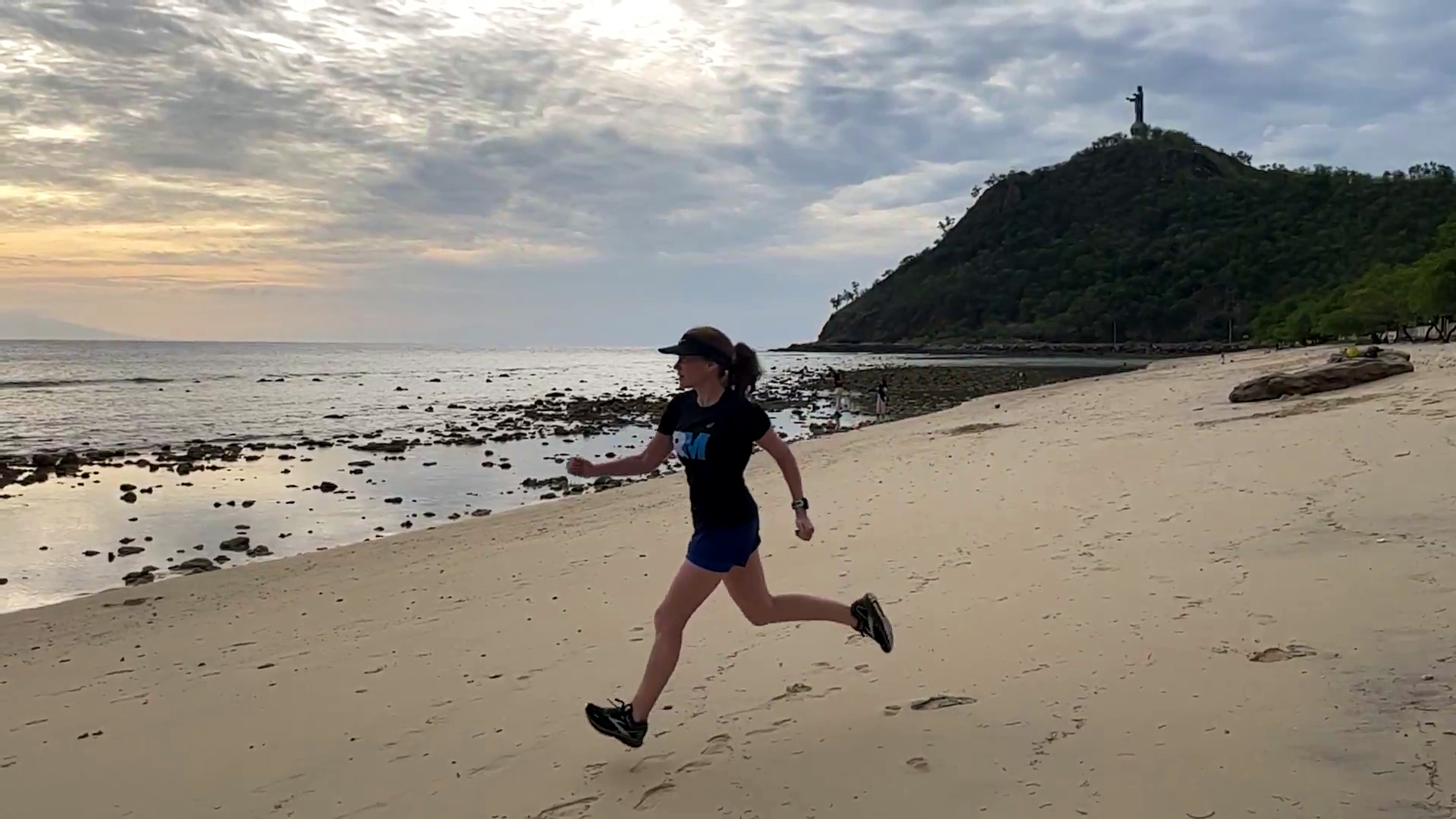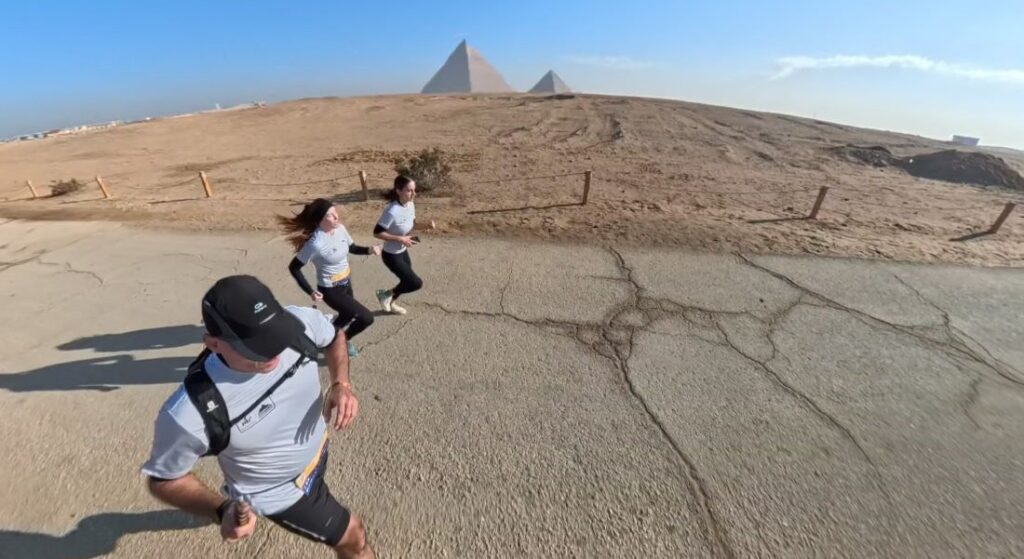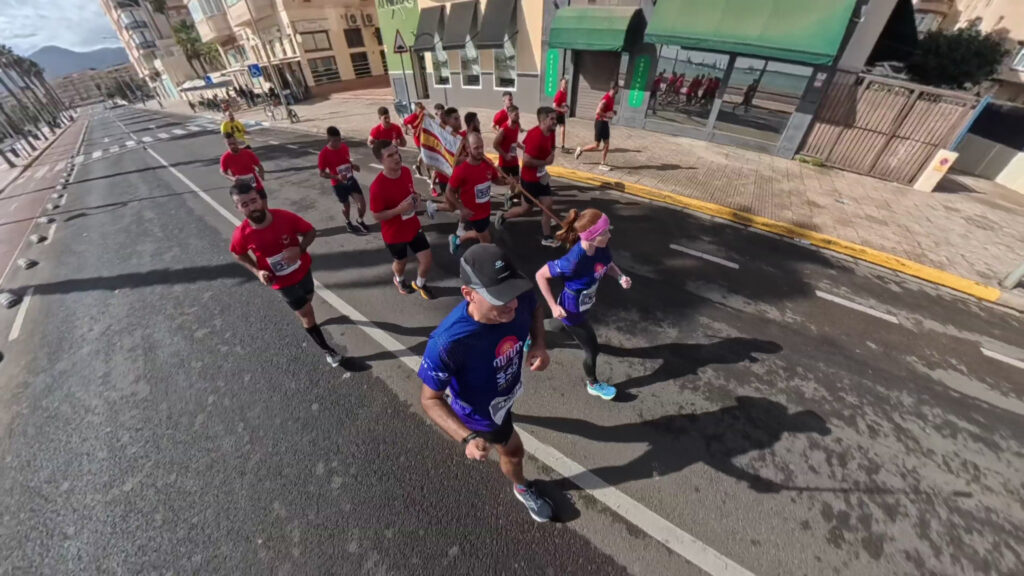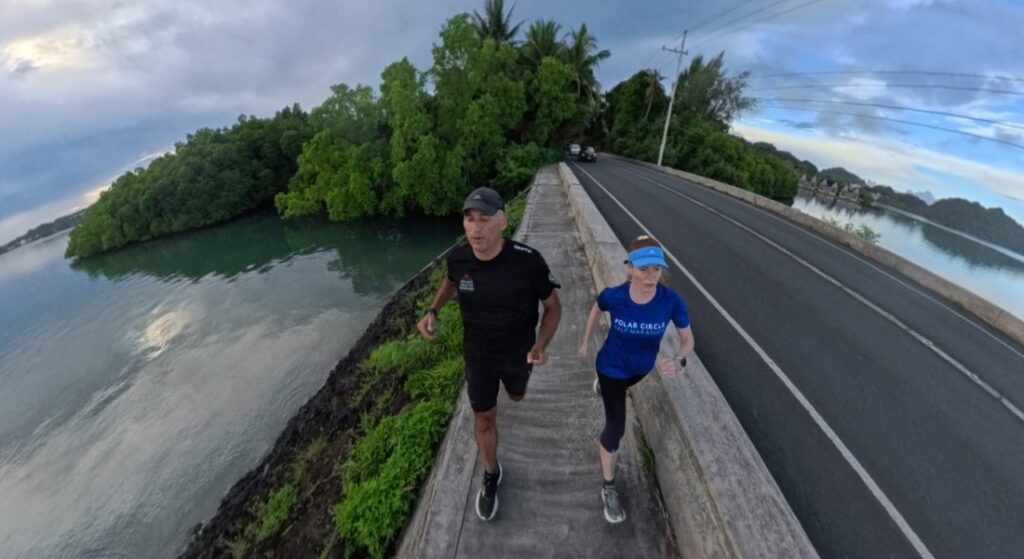Dili, Timor Leste. July 2023.
In the remote and legendary country of Timor Leste, we mingled with the local runners, who were many and were fast, from the urban center along sandy beaches, to end up climbing 500 steps to the foot of the Cristo Rei statue in Cap Fatucama.
TLDR; “too long, didn’t read”
- I just want to run! Take me to RUN.
- I have 1 minute. Take me to USEFUL INFORMATION.
- Running is my excuse for travelling. Take me to TRIP.
- Running is my excuse for eating. Take me to CARBOLOADING.
- I want to know what to read in the plane. Take me to ONE BOOK.
🌍 The trip 📷: What to see in Timor Leste in a couple of days
We arrived in Timor, from Darwin, with a small twin-turboprop commuter plane, an Embraer EMB 120. From the air, when we were approaching Dili, we saw Timor’s characteristic rugged mountains, covered in luscious green vegetation.
The sun was rising and painted the coast line in beautiful orange tones. It was an amazing sight. I would have enjoyed it, had the tiny plane not vibrated very heavily because of air turbulence 🤢.
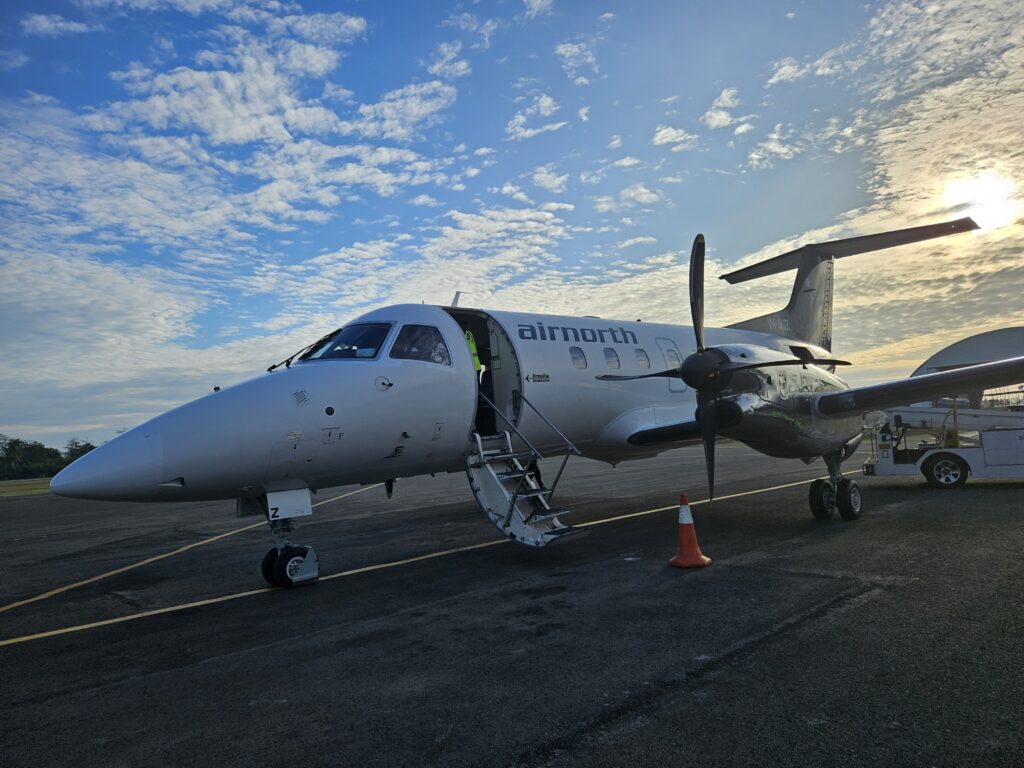
We were only 7 passengers. All locals apart from us and a Pole who got very disappointed when he learnt that he had to pay the “Visa on arrival”. We Spaniards entered for free. There is no visa required if you come from a country belonging to the European Union!
Arriving in Dili
The airport was tiny as well. After discovering that our cell phones got no signal, we got into one of the taxis, painted in bright yellow, which navigated the streets of a very busy city.
Thousands of motorcycles were everywhere, with no respect to traffic rules apart from the need of wearing a helmet:. Curiously, everybody did!
Luckily, our hotel, the Novo Turismo Resort and Spa, received us with a mango juice and a SIM card, which they graciously gave us.
Getting to know Dili
Later we went for a walk in Dili’s waterfront. We wanted to do some sightseeing and inspect the route that we wanted to run.
Upon leaving the hotel, we found a row of very picturesque fruit stalls, displaying the vivid greens, yellows and oranges of bananas, tomatoes, mangos and papayas. Also the exotic touch of bowls of spices, as well as the colorful tais of the lady sellers. Not to upset our stomachs, though, we opted for buying in the local supermarket instead.
We were surprised to see very few of the well known western brands; here everything is local and you will not find the typical “coca-cola”, “nestle” or “lays”. But we did find “Magnum” ice creams and “Fanta”, flavor “Rada Stroberi” (that is: currant).
Being in Timor felt real. Dili is not a beautiful city, but it is unexploited touristically. This is a refreshing change after the “exotic disneyland: rice paddies and temples” that other parts of Southeast Asia have turned into. And the fact that they speak some portuguese made our life easier. We were quick to smile and say “obrigad@” while we paid with US dollars, the currency used here. The change was returned in “centavos”.

Dili’s waterfront
The waterfront is in very poor condition. There is a walk next to the main road, where you can find a massive garbage can as decoration. In a “park” below, nex to the beach, some garbage was burning in the children’s playground. And all over the beachfront, food stalls and motor reparation shops were full of idle guys, surrounded by chickens… and even a goat!
The day after we took the ferry “Success” to go to Atauro island; an island that is a nature gem. Atauro’s coast has the world’s most biodiverse waters. Even us, when walking along their deserted beaches, stumbled upon many coral pieces. It was incredible.
The “Success”!
In the sea, which appeared gray and calm, a lot of small boats, the traditional jukung, were fishing, their hulls painted in light blue. Some other canoes were lying on the rocky beach, next to ugly stalls covered with plastic. The “fish lounge” smelled heavily. It was dirty of plastic bottles and even broken kitchen titles, with more idle guys sleeping on the floor or watching the frantic traffic pass by.
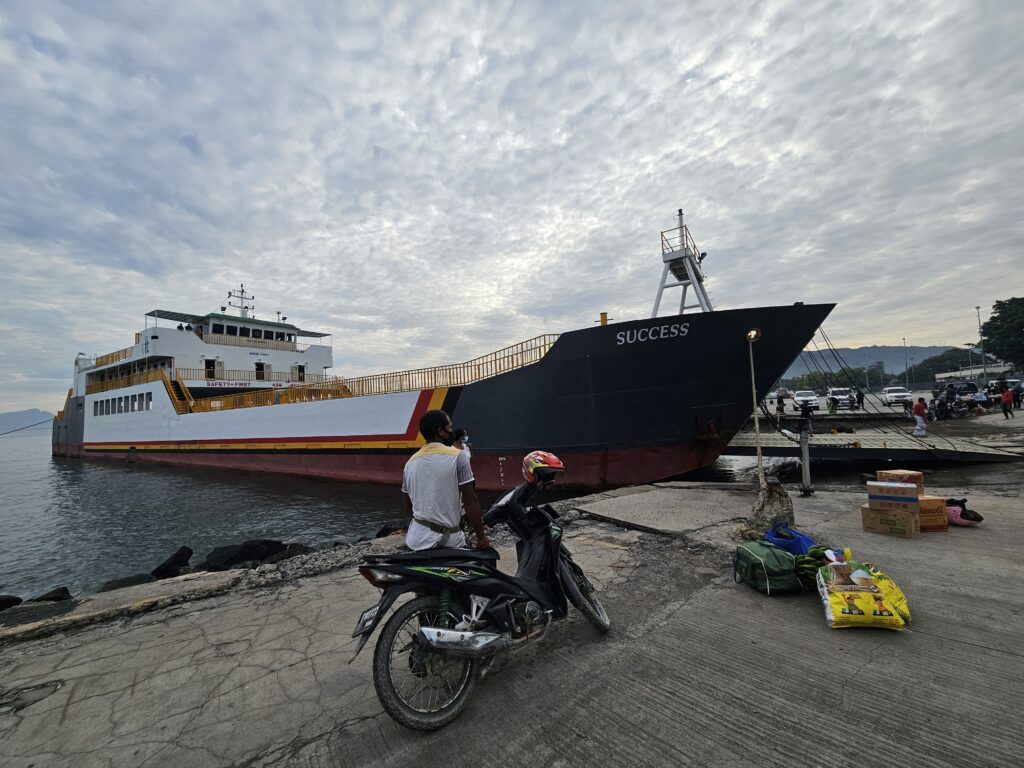
The “Success” ferry cost $5US, and it took us 3 hours. There are several ways to reach the island, Depending on the level of comfort and the speed, the prices largely vary. There are speedboats that cost $75US, or ferries that are faster (named with similar epic names, like “Red dragon”), but they don’t travel every day. Tuesday was “Success” day. So again we did like the locals and slept in the seats while “Black Hawk down” was playing on the ferry’s TVs.
Atauro’s island
Atauro is a beautiful island, not exploited by tourism yet. The good side of this is to be able to enjoy a bath in the pristine and warm waters of the ocean completely alone.
If you have time to dive… you have found paradise! The bad part is how dirty the shores are: there are empty plastic bottles, cigarette butts and cans everywhere.
In the precarious houses made of sheet metal and plastic, some boys called me “bonita”. A truck was decorated with the Barça shield (they had written the name of the sponsor, “Rakuten”). We even saw a solar panel on top of a roof covered with plastic!
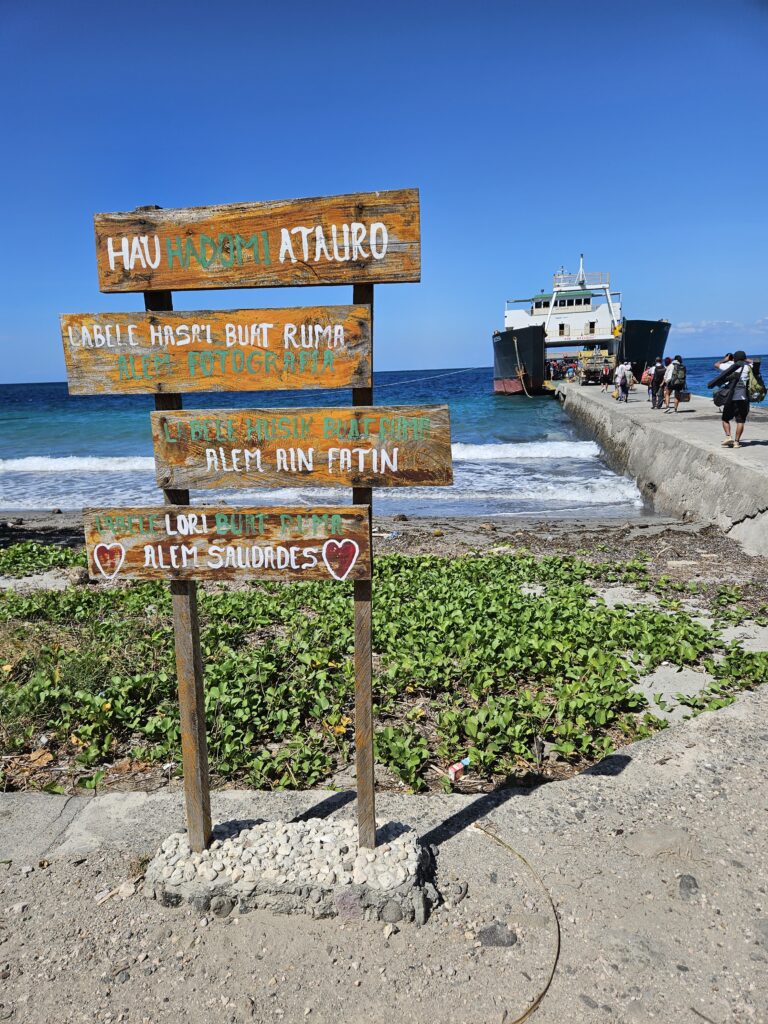
The return trip was 3 more hours, and when we reached Dili we plunged back into their chaotic life, including street fish vendors. Some with large fish hanging from a pole, or others selling smaller ones on cardboard boxes in the asphalt. Right in front of the “government palace”. And near our hotel, a brand new artificial grass soccer field was sponsored by the Chinese; “China aid”. Players ran after the ball; and it is that here the young people seem to be all very fit.
Other options
There are also tours that organize one-day or multi-day trips to learn about the ways of life and customs of indigenous peoples. They advertise explaining that Timor is ideal for those looking for a place “off the beaten track”. Also that here, you will find extremely hospitable people. I totally agree on both things.
In summary, Timor Leste is a very interesting place to visit, especially if one takes into account that it is one of the youngest countries in the world and has a very turbulent recent history.
For 450 years it was a Portuguese colony, and from 1975 to 1999 they fought against Indonesia to win independence. They got it in 2002.
🍜 Carboloading 🍝: What to eat in Timor if you are a runner
For carbo loading, I recommend the national dish of Timor, Batar Da’an. It consists of rice cooked with red beans, is a good source of carbohydrates, and it is vegan! For recovery, we ate a creamy curry made with fish 🐟, Kari Ikan. The hotel served it as one of the options for breakfast 😲. It was actually delicious!
And you can always get grilled corn at one of the stalls on the side of the roads while you run as a snack 😝
🏃♀️ The run🏃♂️
We ran a route that ranges between 10 and 15 kms. From the center of Dili to the Cristo Rei statue, where the locals go to run and do sport. Along the route, we experienced first-hand how popular “running” is here. We saw runners by themselves, in pairs, or even in groups, training at very good paces.
The Cristo Rei is probably Dili’s major landmark: a statue built in 1996 as a present from Indonesia’s President Suharto. It’s 27m high and stands on a world globe, in Cap Fatucama.
First part of the route
The first part of the route runs through the urban center of Dili, and it’s pretty ugly. You can run either in the margins of a busy road along the entire sea front, or on the beaches. It is not possible to run all the route in the sand, as there are some parts where rocks won’t let you pass.
We ran on the road on our way in, and returned running along the beaches as much as possible on our way back.
During this part you are completely immersed in Dili’s life. Including its smells. Carbon dioxide from the exhaust pipes, the smoke of burning garbage in front of shacks with tin roofs, or the smells of fish or roasted corn from street shops.
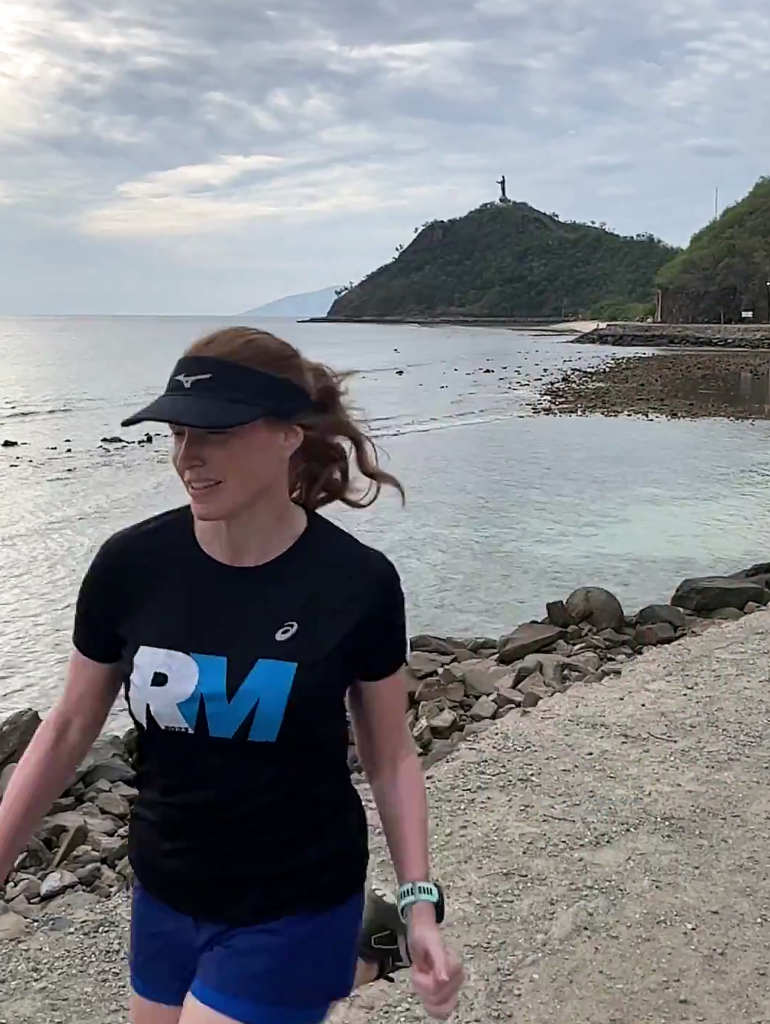
My impression that it is not a touristic place was reinforced: not only did we not see any foreigners, but also no beach bars or souvenir shops. Instead of tourists watching the beautiful sunset, there were only chickens! And no souvenir shops, but shops selling bags with stones for construction.
Leaving Dili
As we left the urban center,we found very poorly paved sidewalks, in front of beaches, in a kind of attempt at “seafront”. We had to watch out for traffic and the poor condition of the pavement.
We passed in front of a traffic control post – written “posto de trafico” in Portuguese-, where 2 policemen languished in front of a roundabout decorated with what once was a cement monument, with peeling paint and a great state of decrepitude. And next to it, a cow quietly walking around.

The route becomes more beautiful later. The dark beaches turn into golden sand beaches, where many locals sit to watch the magnificent sunset over the sea. All with their motorcycles parked up on the road, so you need to be alert when running as you have to get around them. All topped with the beautiful vision of Cristo Rei, in the background, surrounded by green hills of tropical vegetation.
As we got closer, there were also more and more runners, including girls, with soccer team shirts or, directly with the name of their country 🙂.
Fatucama
We arrived at the park at the foot of the mountain, where a small group of shirtless children greeted us from on top of a truck. We took the wrong route and ended up jumping between the rocks of dangerous cliffs before retracing our steps and discovering that the stairs going up were on the other side.
📝 Tip: do not ask “is this the way to go up to Cristo Rei?” because the locals will laugh and always say yes to everything.

In the park from where the stairs go up, there were groups of boys singing with a guitar or groups of young people dressed in a traditional way rehearsing “numbers” of some show, and, of course, a lot of runners.
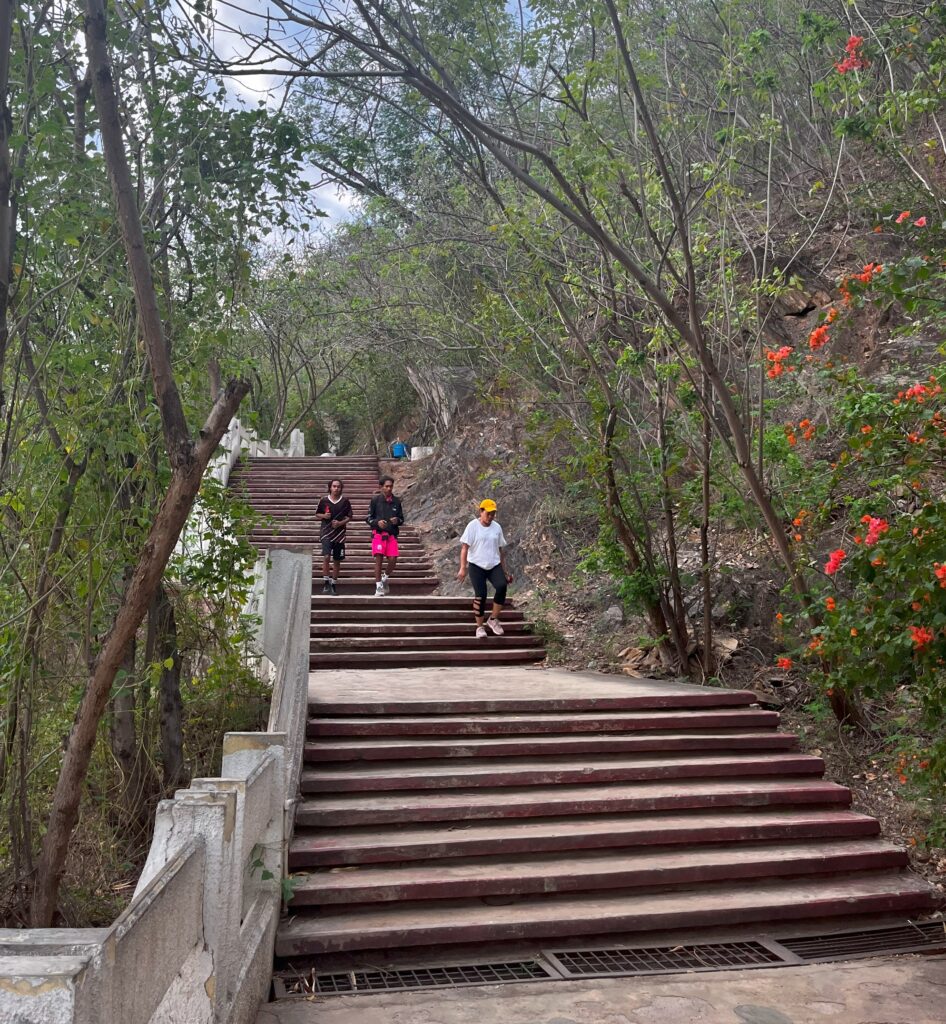
The stairs are decorated with small chapels and offer views of beautiful landscapes of golden sand beaches, but the dirt, again, detracts from the experience. Finding yourself a flushed toilet next to a chapel dedicated to “Veronica wipes the tears of Christ”… is a bit sad 🙁.
Cristo Rei
We arrived at Cristo Rei, huge but in very poor condition, where a couple of runners did planks at its base, while some jumped rope on the esplanade halfway there and others did strength exercises.
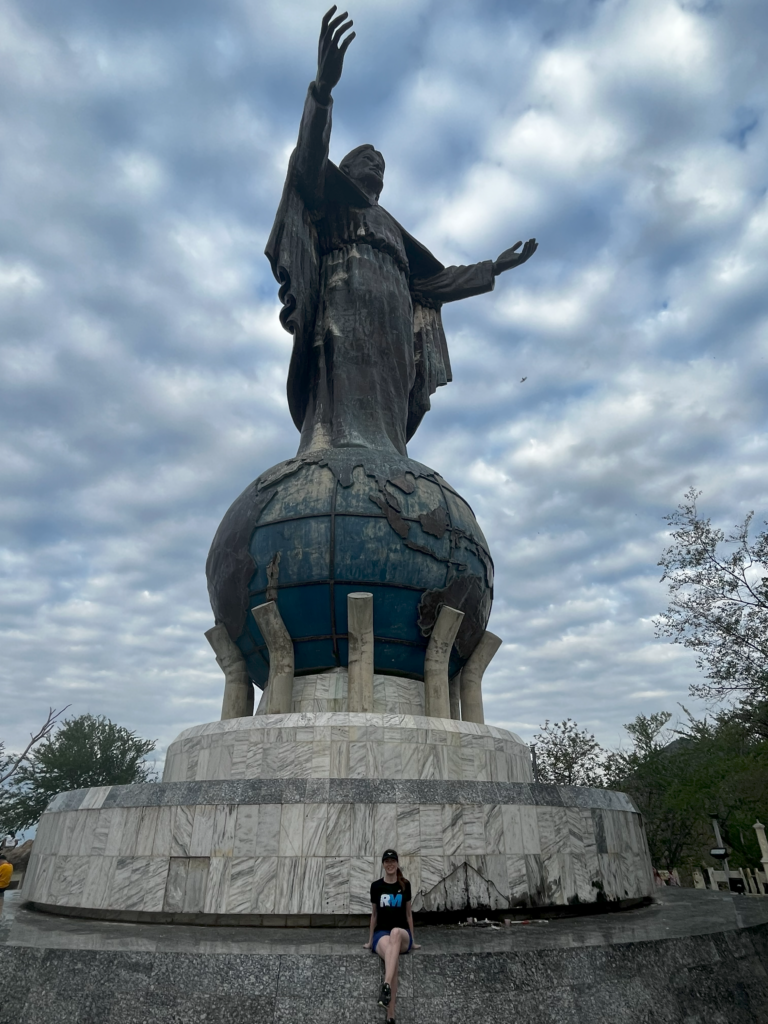
In general, the route is flat, but it is not particularly easy because of the heat, the traffic, and, of course, the stairs to the Cristo Rei.
We went back, this time venturing into the sand of the beaches, and we were left with a good taste in our mouths since the sun was setting and the spectacle of nature was beautiful.

Useful information
🏆 Route between 10 to 15 kilometers from Dili city center (harbor / Government building) to Cristo Rei in Cap Fatucama in Timor Leste.
⛰️ Difficulty: Medium. The route is flat but can be difficult if you run on the sand. Topping up the run with climbing almost 300 steps adds ‘extra’ bonus points.
👟 City shoes could be ok, but trail are better, as you run on asphalt and hard stairs, but also on sand and muddy terrain. As a side note, we saw people running barefoot: as they drive their motorcycles with flip flops and just start running. Bring also sunscreen and hydration, it is very hot and humid.
✅ Experience the local route: Timor people love running and will motivate you to pick up your pace!
✅ Beautiful scenery at the end, almost unspoiled by tourism.
❌ The urban center part is quite ugly and with bad air: not great to breathe the fumes that keep Dili working…
❌ Timor is not easy to get to: there are not too many flights (we flew from Darwin with Airnorth and departed to Bali with Citilink), and it is not particularly cheap. A magnet souvenir in the airport costs $15US!

Map

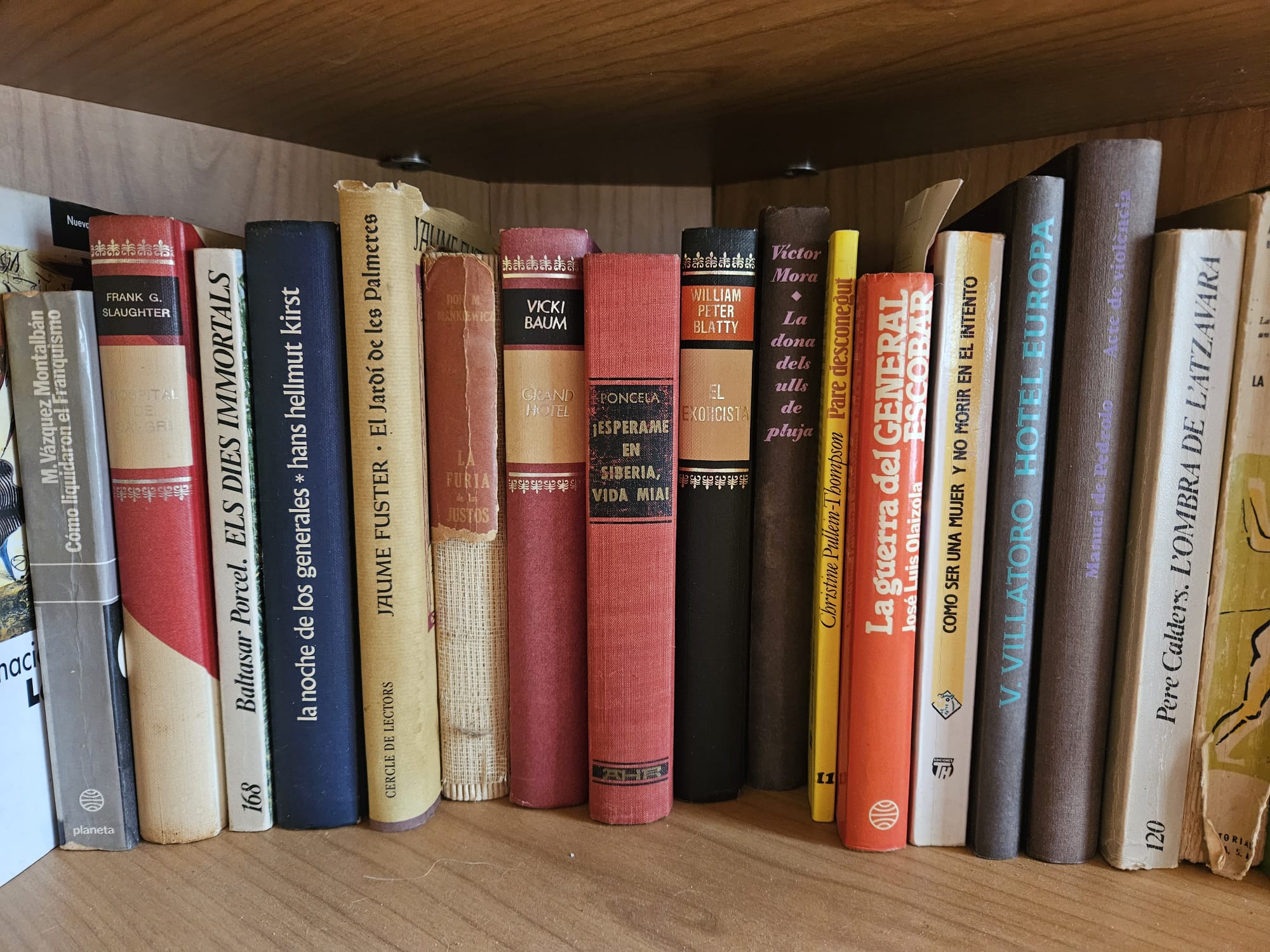
One book
| 📖 “The crossing”, by Luis Cardoso 📖 “The year of living dangerously”, by Christopher Koch 🎬 “The year of living dangerously”, Peter Weir, 1982. |
“The crossing”, by Luis Cardoso.
Probably the best well-known book about Timor, it is a memoir by Luis Cardoso, with the concept of “crossing” linked to his experiences from child to a young adult, and from Portuguese rule to the Indonesian invasion.
⭐⭐⭐⭐
“The year of living dangerously”, Peter Weir, 1982.
The movie is set in Yakarta, Indonesia, but there were so many things in Timor that remitted to this movie (that mesmerized me as a youngster and that still today inspires me), that I include it here.
The Australian movie features a very young Mel Gibson as Guy Hamilton, a journalist sent to Yakarta during the turbulent 1965, when the troops of Suharto overthrow Sukarno’s rule. Since Timor fought for its independence against Indonesia, no less, I couldn’t help but remember the movie during my days in Timor. The same Suharto whose troops articulate the movie was the one that presented the “Cristo Rei” to the Timorese as a present in 1996.
Even the atmosphere in our hotel appeared to me like the way of living of the expats, with a great swimming pool, very different from the bursting, dusty and chaotic life of the surrounding streets.
⭐⭐⭐⭐⭐
“The year of living dangerously”, Christopher Koch.
The movie is based on a book by Christopher Koch, narrated by “Cookie”. Reading the book allows you to understand better the complexity of the situation narrated.
⭐⭐⭐⭐

